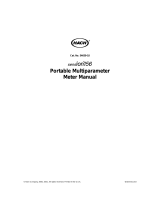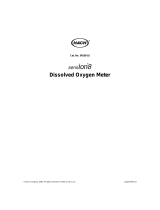
Section 8 Troubleshooting
Problem Possible cause Solution
Decreased probe performance
causes slow stabilization and
prevents accurate calibrations or
measurements.
The sensor cap is loose or
damaged.
Tighten or replace the sensor cap. Always
replace the sensor cap and the iButton at the
same time. Refer to Replace the sensor cap
and iButton on page 9.
Water is between the sensor
cap and the probe lens.
Remove the sensor cap and dry the probe
lens. Refer to Replace the sensor cap and
iButton on page 9.
The sensor cap is not
sufficiently conditioned.
Keep the probe in the BOD bottle with some
water for more time, then try the calibration
again.
The temperature or pressure
sensor does not operate
correctly.
Compare the temperature and pressure
readings of the probe with external
measurements. The pressure sensor reads
absolute pressure, which is not adjusted to
sea level. If the measurements are not
correct, contact technical support.
The lot code on the iButton is
not the same as the lot code
on the sensor cap.
Replace the sensor cap and iButton.
The stirrer does not operate
correctly.
The stirrer does not operate. The stirrer uses the power from the meter to
operate. Make sure to start the meter, then
start the stirrer.
The stirrer turns only when the
probe is not in a BOD bottle.
Remove and install the stirrer assembly.
Refer to Replace the stirrer on page 10.
The stirrer makes a lot of
noise.
Remove and install the stirrer assembly.
Refer to Replace the stirrer on page 10.
Sample properties cause slow
stabilization or inaccurate
measurements.
The measurement was not
adjusted for salinity in the
sample.
Measure the salinity of the sample and enter
the value as a salinity correction factor in the
meter.
Procedure problem causes slow
stabilization and prevents
accurate calibrations or
measurements.
Air bubbles are around or
below the probe tip.
Carefully tap or shake the probe to remove
air bubbles.
The contents of the BOD bottle
did not fully adjust to ambient
temperature.
Wait more time for the contents of the BOD
bottle to adjust to ambient temperature.
Section 9 Consumables
Note: Product and Article numbers may vary for some selling regions. Contact the appropriate distributor or refer to
the company website for contact information.
Description Quantity Item no.
LBOD sensor cap replacement kit (includes iButton) 1 5838000
LBOD probe replacement stirrer assembly 1 5850800
LBOD stirrer bearing clip 1 5852800
BOD bottle with glass stopper, 300 mL 1 62100
Beaker, 250 mL, polypropylene 1 108046
Cobalt chloride solution 500 mL 1422249
Sodium sulfite 100 g 2386026
English 11





















